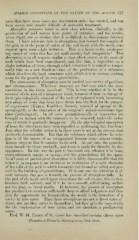Page 767 - My FlipBook
P. 767
MORBID CONDITIONS OF THE FLUIDS OF THE 3I0UTH. 777
cases that have come under my observation caries has existed, and has
been severe and usually difficult of successful treatment.
Absorptive prooesses stand in such close relation, clinically, to the
production of acid mucus from points of irritation, and the results,
when slight, are so similar, that it is difficult to discriminate between
them. I have reference here to absorptions just beneath the margin of
the gum or at the point of union of the soft tissue with the tooth, con-
sequent upon some slight irritation. This is a factor in the predispos-
ing causes of caries that has not until recently had recognition.^ This
absorption is in all respects similar to that Avliich occurs at the roots of
teeth which have been transplanted, and, like that, is dependent on a
slight irritation of tissue, through which irritation it is caused to tempo-
rarily take on a new function—that of the production of a substance
which dissolves the hard structures with which it is in contact, making
room for the growth of its own granulations.
The phencjmena of absorption may be studied in a variety of positions
and circumstances. Wherever observed, we find very much the same
conditions in the tissue involved. This is true whether it be in the
removal of the root of a temporary tooth, removal of bone in change of
form (physiological), removal of the roots of replanted teeth, burrowing
into pieces of ivory that have been thrust into the flesh for the purpose
of experiment (Krause, Koelliker, Tomes), removal of sponge in the
sponge-graft, or the absorpti(jn of the surgeon's animal-membrane liga-
tures (pathological). In all cases granulation-cells or leucocytes are
brought in contact with the substance to be removed, under the influ-
ence of which it gradually disappears. (In the physiological absorption
of bone the osteoblasts have been regarded as performing this function.)
Just what the cellular action is in these cases is not at the ])resent time
positively demonstrable. But that the substance which effects the solu-
tion is of the nature of an unorganized ferment seems almost certain.
Krause suggests that it contains lactic acid. At any rate, the granula-
tions invade the tissue gradually, and room is made for thcm^Dy its dis-
appearance. In this way the part is burrowed out, whether it be bone,
tooth-substance, catgut, or sponge, and the granulations fill the space.
In all cases of pathological absorption it is fairly demonstrable that the
action is in response to an irritation or excitement of a mild character
of the cells of the part in which leucocytes are formed or called and pro-
ceed to the building of granulations. If in any case the irritation is of
such intensity that pus is formed, the process of absorption fails. As
the ])art of the tooth acted uj)on rises above the soft tissues, this in time
becomes dark colored ; and if it be on a smooth, self-cleaning surface
not too deej), no decay results. If, however, the process of absorption
has produced excavations sufficiently deep to afford lodgments and thus
give the opportunity for fermentation, the result is the formation of a
cavity by true caries. Then these absorptions are not a direct cause of
decay, nor are they caries in themselves ; but they give the opportunity
for the implantation of true caries, and are therefore a predisposing
cause.
Prof. W. H. Eames of St. Louis has described certain effects upon
^ Formation of Poisons by Micro-orcjanisnis, 1884, Black.


